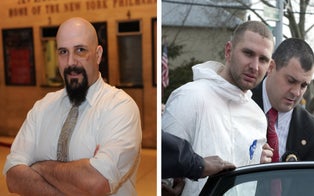The trio of activists behind the project explain that 'Slavers of New York’ is an education project, naming and identifying and educating the people in the community about who the streets that they live around are named for.
If you’re in certain neighborhoods of New York City, you might notice “Slavers of New York” stickers popping up on street signs. The stickers are part of a new initiative to cite historical records and call out figures from the city’s past as owners of enslaved people.
The trio of activists behind the project; Elsa Eli Waithe, Ada Reso and Maria Robles, recently explained the cause in detail.
Elsa states, “’Slavers of New York’ is what we've dubbed as a guerrilla education project, naming and identifying, and educating the people in the community about who the streets that they live around are named for.”
And according to Ada, the goal is to expose the legacy of racism and slavery in New York City. “And we do that by taking historical data and presenting it to the people in public spaces,” she says. “And that's usually by means of stickers that we paste all over public spaces in the city.”
The trio will select a street to highlight and then find one or more facts about that person and put it on the sticker. Ideally, the goal is to educate as many New Yorkers as possible, providing access to information and igniting conversations around the history of slavery in the city.
Elsa explains that their first “Slavers of New York” stickers were for Nostrand Ave, a street in Brooklyn. “Nostrand Ave. is seven miles long in Brooklyn,” she says. “And what was really egregious to me and what's really outrageous to me is the fact that Nostrand runs through several predominately Black, historically Black neighborhoods. And John Van Nostrand and the family Nostrand were very instrumental in the slave trade in New York.”
They also highlighted and made stickered info for the name Stuyvesant. And in New York, there is a Stuyvesant Street in Manhattan, a Stuyvesant Avenue in Brooklyn, the neighborhood of Bedford-Stuyvesant and Stuyvesant High School. According to Maria, they are named after Peter Stuyvesant, the first director general of the colony when it was a Dutch colony. He was a large slave trafficker in the late 1600s and 1700s, and he also enslaved many people on his farm.
Maria Robles adds that their most recent sticker is for Cortelyou Road in Brooklyn. The Cortelyous were a large land-holding farming family in Brooklyn, and they owned slaves.
The trio brings up valid questions regarding these people whose names are seen all over the city. Elsa said, “Some of these folks were just people who had land. People who just had money. So why does that get remembered? Why does that get into the culture?”
Ada adds, “What does it mean to live on a street that carries the name of someone who enslaved people? If these names are the streets that are the names that we repeat on a day-to-day basis as we move through our city, who are the people that were glorified and why?”
Maria says that it's all a reminder of how pervasive the history of slavery and the impact of slavery has been. She also points out that oftentimes, when conversations come up around the history of slavery in the U.S. specifically, it's very often focused on the South. But in fact, it was very prominent in New York City.
“New York City was at one point, aside from Charleston, the largest slaveholding city in the country. And I think a lot of New Yorkers don't know that. Or they don't think about it. And that history is not really shared or talked about much. “
With this project, the trio of activists for “Slavers of New York” hope to educate others. According to Ada, “We're giving the information so that we can all collectively agree that structural change is absolutely necessary. And the past will provide us the window to the future, “
“Our stated goal has never been to actually change the names of the street. We would like to stay above those controversies,” Elsa lastly adds. “But the fact of the matter is a lot of people don't know what's around them. And if you don't know what's around you, then you have a hard time affecting any sort of change."





